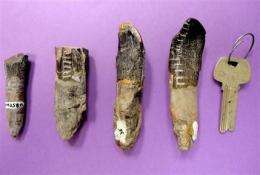Teeth study shows big dinosaurs trekked for food

What did giant plant-munching dinosaurs do when they couldn't find enough to eat in the parched American West? They hit the road. An analysis of fossilized teeth adds further evidence that the long-necked dinosaurs called sauropods - the largest land creatures - went on road trips to fill their gargantuan appetites.
Scientists have long theorized that sauropods foraged for precious resources during droughts because of their preserved tracks and long limbs that were "ideal moving machines" and allowed them to cover long distances, said paleobiologist Matthew Bonnan of Western Illinois University.
The latest study is the best evidence yet that at least one kind of sauropod "took to the hills in search of food when times got tough in the lowlands," said paleontologist Kristi Curry Rogers at Macalester College in Minnesota.
The new work, published online Wednesday by the journal Nature, was led by geologist Henry Fricke of Colorado College.
The researchers analyzed 32 sauropod teeth collected in Wyoming and Utah. The teeth came from massive plant-eaters that roamed a semi-arid basin in the American West during the late Jurassic period about 150 million years ago.
The largest sauropods weighed 100 tons and were 120 feet long. The type in the study was smaller - about 60 feet in length and weighing 25 tons.
Scientists can get a glimpse into the source of the dinosaurs' drinking water by comparing the oxygen preserved in the tooth enamel to that found in ancient sediment.
A chemical analysis showed differences in the teeth and the basin where the dinosaurs were buried, meaning they must have wandered hundreds of miles from the flood plains to the highlands for food and water.
Fricke said the movement appeared to be tied to changing seasons. Sauropods left the basin in the summer for higher elevations - a trek that took about five months - and returned in the winter.
In lush times, sauropods would have feasted on a diversity of plants including ferns, horsetails, conifers and moss, said John Foster, a curator at the Museum of Western Colorado, who had no part in the research.
More information: Journal: http:// www.nature.com/nature, DOI: 10.1038/nature10570
©2011 The Associated Press. All rights reserved. This material may not be published, broadcast, rewritten or redistributed.



















